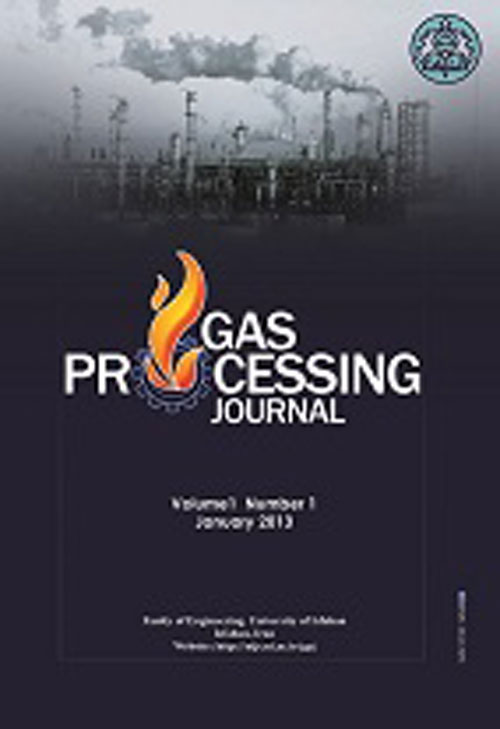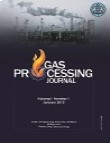فهرست مطالب

Gas Processing Journal
Volume:10 Issue: 1, Winter 2022
- تاریخ انتشار: 1401/06/15
- تعداد عناوین: 8
-
-
Pages 1-18A new concept for hydrogen liquefaction with a capacity of 300 tons per day is developed through the modification of an existing one. Pressure and temperature levels, mixed-refrigerant composition, and different configurations are explored to achieve a new concept with lower SEC and higher COP. Aspen HYSYS V9 is used to simulate the process. Exergy and energy analyses are employed for evaluating the process to capture the effect of changes. As different parameters of the liquefaction process are interlinked and depend on each other, optimization is done using a trial and error procedure. Modified-Benedict–Webb–Rubin and Peng-Robinson equations of state are utilized to simulate hydrogen and mixed refrigerant streams to increase the accuracy of the results, especially for the ortho-para conversion. Power consumption of the coolers is considered, and exergy destruction for all the components is calculated. It is found that ortho-para converters and separators could affect the total exergy destruction and efficiency of the process; however, their exergy efficiency is nearly 100%. The SEC of the new concept is 5.97 kWhr/kg, which shows an 18.8% improvement compared to the base concept. The COP and ε are improved by 14.4% and 15.5% too. The results show that the liquefaction section is responsible for 85% of the total SEC of the process, and it deserves to focus on this section for future studies.Keywords: Hydrogen Liquefaction, Exergy Analysis, Aspen HYSYS, Mixed-refrigerant, Ortho-Para Conversion
-
Pages 19-43
Energy quality is a very important criterion, which affects the economic growth of that country. In this study, a real-life case study Natural Gas Liquids plant 800, from National Iranian South Oil Company located in the southwest of Iran was considered by conventional exergy analysis, advanced exergy analysis, combined pinch and exergy analysis, and combined pinch and advanced exergy analysis methods. The results of conventional exergy analysis illustrate that the highest amount of exergy destruction belongs to compressors and heat exchangers with 510 and 629 kW respectively. The advanced exergy analysis suggested that the exergy destruction of the heat exchanger and compressor and will reduce by modifying the performance of these components. However, according to this analysis, for (E-101) heat exchanger despite having the highest rate of exergy destruction, is not in the priority of modification due to its low level of avoidable exergy destruction. Also, the avoidable, endogenous part of exergy destruction of the compressor (K103) and heat exchanger (E-102) will reduce by improving the performance of these components. In the following, and by using the combined Pinch and advanced exergy analysis diagram, it was possible to display simultaneously the energy consumptions rate and the unavoidable exergy destruction of the heat exchanging network. According to this graphical analysis, the plant's minimum hot and cold required utilities are equal to 411 and 10,211 kW, respectively for ΔTmin of 10.645 °C. And heat exchanger E-102 has more priorities of improvement compared to other heat exchangers.
Keywords: NGL plant, Pinch, Conventional exergy analysis, Advanced exergy analysis, Combined Pinch, exergy analysis, Combined pinch, and advanced exergy analysis -
Pages 45-66The southern part of Iran has many CO2 emission sources and considerable potential for storage and utilization demand of CO2 such as oil and gas wells. Based on the importance of CO2 pipeline transport in CCS projects, this study was conducted to develop a budget-type techno-economic model for CO2 transmission through pipelines on the southern coasts of Iran. Although the design of a pipeline project with detailed economic investigations has a lower error, it needs spending a lot of time and cost. Therefore, it is necessary to create a budget-type techno-economic model that includes key technical and economic specifications of CO2 transmission pipelines for Iran like similar studies for other countries. In the present study, first, the requirements and the process of construction of a pipeline were described. Then, different economic budget-type models were developed based on the results of different technical models and the investment costs of the pipelines, booster stations, etc. It is worth mentioning that the developed budget-type techno-economic models have uncertainties due to various technical and economic parameters involved in the modeling. Therefore, a stochastic analysis was performed based on the input parameters of the model. For the case study, the pipeline diameter, the investment cost for the 110-km pipeline, and the levelized cost were calculated to be 0.273 m, 18.37 million €, and 1.55 €/ton, respectively which can be for the basic design of CO2 pipelines.Keywords: CO2 transmission pipeline, carbon dioxide capture, and storage, techno-economic models, levelized cost, stochastic analysis
-
Pages 67-84
Hybrid power and desalinated water generation systems with two Multi-Effect Distillation (MED) technologies and Reverse Osmosis (RO) are investigated for a combined-cycle power plant in this study. The generated steam enters MED from the low-pressure section of the Heat Recovery Steam Generator (HRSG) in the hybrid system. Seawater is divided into two sections after entering the MED condenser – one part is fed into MED and its process. The other is rejected after cooling in the condenser and turns back to the sea. A reverse osmotic desalination system is implemented in this study. In the present combined cycles, steam generated in the Low Pressure (LP) section enters the steam turbine. To reduce the generated power and increase desalinated water in MED and RO, exergy analysis and cycle optimization are required. The system is simulated and verified based on the available data on the model power plant. The results showed that by selecting 43 optimization parameters and applying constraints like acidification temperature, the integrated cycle's exergy efficiency could be raised by 50%. Under this condition, the water price is calculated to be 1.16 $/m3. Under hybrid conditions of the design power and freshwater cogeneration system, the present design's efficiency without optimization and its final cost is 48.8% and approximately 1.2 $/m3.
Keywords: Hybrid desalination system, MED, RO, combined cycle, economic analysis, exergy -
Pages 85-94
Landfill gas is one of the most important constituents in greenhouse gas production, but, it could be easily eliminated by using it in an engine as an alternative to conventional fuels. Because, there are several concerns about the use of LFG as fuel, therefore, the present study seeks to analyze the performance of the Iranian heavy-duty diesel engine (D87) under RCCI combustion fueled with diesel fuel and LFG. The main objectives of this study are to overcome the limitations of using LFG in the D87 engine as an alternative fuel, improve the D87 engine combustion characteristics, and reduce engine emissions. For this purpose, the effects of four major influential input parameters on the D87 engine performance were evaluated, namely, the IVC temperature and pressure, the diesel fuel SOI timing, and the LFG/diesel fuel mass ratio. The DOE concept-Factorial method was employed to predict the appropriate ranges of the selected four crucial parameters that lead to the desired performance. The simulation results show that the desirable engine performance would be achieved for the IVC temperature between 350 and 400K, for the IVC pressure between 2.6 and 2.9 bar, for the diesel fuel SOI timing between -75 and -30º ATDC, and the LFG/diesel fuel mass ratio between 70/30 and 85/15. Although, the hydrocarbon fuel consumption can be reduced by more than 80% byG, the downfall is that the EURO VI level for NOx, CO, and UHC and also the EPA 2007 level for Formaldehyde cannot be met.
Keywords: RCCI Combustion, Heavy-duty diesel engine, LFG, DOE concept, Factorial method -
Pages 95-112
The presence of water vapor in natural gas can cause several problems such as corrosion in transmission pipelines, blockage of equipment, and reduction of pipeline capacity. Dehydration is a critical step to reduce the water content to prevent these serious drawbacks. The adsorption process is one of the efficient technologies for producing natural gas with low water content. In this study, the industrial molecular sieve-based dehydration unit is simulated. After validating the simulation results with the plant data, the effect of feed gas cooling before entering the dehydrator on the hydrate formation temperature of the produced dry gas is investigated. To do so, we simulate the dehydration unit with a pre-cooler and design the heat exchanger to reduce the feed gas temperature. In addition, we investigate the effect of temperature reduction on the temperature of hydrate formation and water content for dry gas products. On the other hand, the effect of heating time in the regeneration step on the unit performance is discussed. Because of sufficient cooling operation, the temperature of hydrate formation reduces significantly. For the reduction of 15℃ in the feed temperature, about 50% reduction in the product water content is attained. As a result, the improvement of 6 to 7˚C in the temperature of hydrate formation is achieved for the proposed dehydration process with the pre-cooler in comparison with a simple dehydrator scheme depending on pressure. For the proposed heating time of 8000s, the rise of 6.8% in the total amount of the removed water is achieved.
Keywords: Adsorption, Dehydration, Molecular sieve, Natural gas, Simulation -
Pages 113-124
One of the most crucial variables in the study of heat transport is thermal conductivity and methods for measuring this variable have long been sought after. In this paper, to achieve the equation for approximation of the thermal conductivity coefficient, 61 experimental data were collected for pure gases in P=1 bar and variable temperature (91.88-1500 K). The proposed model was then obtained using the Particle Swarm Optimization (PSO) algorithm in MATLAB V2015. It includes a variety of hydrocarbon and non-hydrocarbon compounds. The physical properties of pure gases including temperature, critical temperature, critical pressure, molecular weight, viscosity, and heat capacity at constant volume were obtained for pure components and used for prediction of the conductivity of these gases. Also, during the validation phase, the suggested model attained the most accurate prediction withR^2=0.9995. This model is capable of predicting the thermal conductivity coefficient of gases with a mean relative error percentage of 4.67% and mean square error percentage of 2.4210×10-4% compared to actual data. These results are significantly better than those obtained from other models.
Keywords: heat transfer, thermal conductivity, pure gas, particle swarm optimization algorithm -
Pages 125-136
Gasoline produced from fluid catalytic cracking (FCC) units contains substantial amounts of sulfur, which contributes to pollution. This study focuses on the hydro-desulfurization of gasoline in a fixed-bed reactor using computational fluid dynamics (CFD). The study provides a comprehensive analysis of reactor performance by investigating various parameters such as velocity, pressure, and temperature contours at different sections of the reactor. The visualization of these variations helps understand the hydro-desulfurization process in greater detail and aids in optimizing desulfurization technology. The simulations were conducted and validated results using operational data from the hydrogen refining unit of Abadan Oil Refining Company. The highest temperature was observed along the central line of the reactor, and the maximum pressure drop occurred in the catalytic section. The concentration of hydrogen sulfide (H2S), a product of the hydro-desulfurization reaction, increased by 15-fold and reached 0.008 kmol/m3 as it moves moved from the entrance to the outlet of the reactor. Additionally, the productivity of the reaction, as well as the molar concentration of H2S, increased with an increase in the feed mass flow rate. However, it should be noted that an increase in the feed temperature resulted in higher reaction yields, but it might also lead to the reduced thermal resistance of the catalyst, potentially affecting its effectiveness. Additionally, the concentration of gasoline and hydrogen decreased from the reactor inlet to the outlet, while the concentration of H2S increased.
Keywords: hydro-desulfurization, fixed bed reactor, CFD, simulation, gasoline


